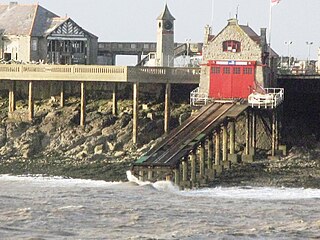
The Mumbles Lifeboat Station is at Mumbles Pier, located at the south-western corner of Swansea Bay, near the village of Mumbles, within the city and county of Swansea, in the historic county of Glamorgan, Wales.

Weston-super-Mare Lifeboat Station is a lifeboat station at Weston-super-Mare in Somerset, England. For more than 100 years it was situated on Birnbeck Island but is now in a temporary building at Knightstone Harbour until a new lifeboat station can be built nearby. It is operated by the Royal National Lifeboat Institution (RNLI). The first lifeboat was stationed in the town in 1882, and since 1969 it has only operated inshore lifeboats (ILBs), currently a B-class and a smaller D-class (IB1).

Angle Lifeboat Station is located near the village of Angle, on the southern side of the entrance to the Milford Haven Waterway in Pembrokeshire, Wales.

Fowey Lifeboat Station is the base for Royal National Lifeboat Institution (RNLI) search and rescue operations at Fowey on the south coast of Cornwall in the United Kingdom. The first lifeboat was stationed in the area in 1859 and the present station was opened in 1997. It operates a Trent Class all weather boat (ALB) and a D class (IB1) inshore lifeboat (ILB).

Appledore Lifeboat Station is the base for Royal National Lifeboat Institution (RNLI) search and rescue operations at Appledore, Devon, England. The first lifeboat was stationed in the town in 1825 and the present station was opened in 2001. It operates a Tamar-class all-weather boat (ALB) and an Atlantic 85 B Class inshore lifeboat (ILB).

St Ives Lifeboat Station is the base for Royal National Lifeboat Institution (RNLI) search and rescue operations at St Ives, Cornwall in the United Kingdom. The first lifeboat was built for the town in 1840 and the present boathouse was opened in 1994. It operates a Shannon-class All-weather boat (AWB) and a D-class (IB1) inshore lifeboat (ILB).

Teignmouth Lifeboat Station is the base for Royal National Lifeboat Institution (RNLI) search and rescue operations at Teignmouth, Devon in England. The first lifeboat was stationed in the town in 1851 but the station was closed from 1940 until 1990. Since 2006 it has operated an Atlantic 85 inshore lifeboat (ILB).

Poole Lifeboat Station is the base for Royal National Lifeboat Institution (RNLI) search and rescue operations at Poole, Dorset in England. The first lifeboat was stationed at Poole Harbour in 1865 and the present station was opened in 1988.

Barmouth Lifeboat Station is located in Barmouth, a town at the mouth of the Afon Mawddach river in Gwynedd, Wales. A lifeboat was first stationed here by the Royal National Institute for the Preservation of Life from Shipwreck (RNIPLS) in 1828.

Port Erin Lifeboat Station is located in the town of Port Erin in the Isle of Man. The Royal National Lifeboat Institution opened a station here in 1883 following requests from local residents.

Fleetwood Lifeboat Station is located on The Esplanade at the port of Fleetwood, a Lancashire town at the north end of The Fylde, situated at the mouth of the River Wyre.

Silloth Lifeboat Station is located at the end of Lawn Terrace, in Silloth, a port town sitting on the Solway Firth, approximately 20 miles (32 km) due west of Carlisle, on the north west coast of Cumbria.
Kilmore Quay Lifeboat Station is the base for Royal National Lifeboat Institution (RNLI) lifeboat at Kilmore Quay in County Wexford, Ireland. It was known as just Kilmore Lifeboat Station until 1986.

Wexford Lifeboat Station is the base for a Royal National Lifeboat Institution (RNLI) inshore lifeboat at Wexford in Ireland.

Fethard Lifeboat Station is the base for a Royal National Lifeboat Institution (RNLI) inshore lifeboat at Fethard-on-Sea on the south coast of County Wexford, Ireland.

Courtown Lifeboat Station is the base for a Royal National Lifeboat Institution (RNLI) inshore lifeboat at Courtown on the east coast of County Wexford, Ireland.

Ardmore Lifeboat Station was located at the junction of Main street and Cois Trá in Ardmore, a seaside resort and fishing village in County Waterford, on the south coast of Ireland.

Southend (Cantyre) Lifeboat Station was located in the shadow of Dunaverty Rock, overlooking Dunaverty Bay, near Southend, a village on the southern tip of the Mull of Kintyre, in the county of Argyll and Bute, on the south-west coast of Scotland.

Huna Lifeboat Station was located at Huna, a hamlet on the north eastern tip of the Highland region of Scotland, historically Caithness, overlooking the Island of Stroma in the Pentland Firth, and sitting just over 1 mile (1.6 km) to the east of John o' Groats.

Lossiemouth Lifeboat Station was located in Lossiemouth, a harbour town sitting midway between Inverness and Fraserburgh on the Moray coast, in north-east Scotland.






















